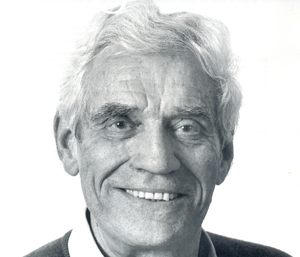John Gardner
Composer of A Burns Sequence

John Gardner was born in Manchester on 2nd March 1917 and brought up in Ilfracombe, North Devon. His father Alfred Linton Gardner, a GP and amateur composer, was killed in action in the last months of the First World War. Gardner was educated at Eagle House, Wellington College and Exeter College, Oxford. An important figure in his early career was Hubert Foss of Oxford University Press, who published the Intermezzo for Organ in 1936 and introduced him to the composer Arthur Benjamin to whom Gardner dedicated his Rhapsody for Oboe and String Quartet (1935). His String Quartet No.1 (1938) was broadcast from Paris by the Blech Quartet in 1939, and the anthem The Holy Son of God most High (1938) was also published by OUP.
Gardner treated the end of the War as a new start, set aside his juvenile works and began again from Opus 1, his job as a repetiteur at the Royal Opera House, Covent Garden giving him the time to devote to composing. John Barbirolli discovered the First Symphony, Op2 when he gave Gardner the opportunity of playing through his Nativity Opera. By Gardner's own admission, this work is "unperformable", but Barbirolli was sufficiently interested to ask to see other works. Gardner showed him the Symphony. Barbirolli asked for some re-working of the first movement and scheduled the work for the 1951 Cheltenham Festival where it caused a minor sensation. Here was a huge, powerful work, brilliantly scored and masterfully structured, by a composer of whom almost no-one had heard.
Many major commissions followed and Gardner was finally able to call himself "a composer". He resigned the job at the Opera House and there followed a remarkable period of creativity. Cantiones Sacrae, Op11, Variations on a Waltz of Carl Nielsen, Op13 and the ballet Reflection, Op14, were all written in 1951 and 1952 and first performed during 1952. He re-wrote A Scots Overture, previously a military band piece, for the 1954 season of Promenade Concerts in 1954. In May 1957 Sadler's Wells put on the opera The Moon and Sixpence, which they had commissioned, and two other major works were premiered that year: the Piano Concerto No.1 (by Cyril Preedy and Barbirolli at the Cheltenham Festival) and the Seven Songs, Op36 in Birmingham, a work which Gardner wrote as "light relief" whilst working on the other major works.
In 1956 he was invited by Thomas Armstrong to join the staff of the Royal Academy of Music, where he would teach for the best part of 30 years. In 1962 he took a part time job as Director of Music at St. Paul's Girls' School, following Gustav Holst and Herbert Howells, and was for a time also Director of Music at Morley College. These teaching posts led to the composition of some of his most enduring works, and together with the many holiday courses he worked on as a conductor (Canford, Dartington, ESSYM, Bernard Robinson's Music Camp, etc., etc.) ensured that he was able to bring practical experience and knowledge to bear on his compositions.
Gardner has composed prolifically throughout his life. Among the major works are two more symphonies, two more operas - The Visitors (1972) and Tobermory (1976), concertos for Organ, Trumpet, Flute, Oboe and Recorder and Bassoon, many cantatas, including The Ballad of the White Horse, Op40 (1959), Five Hymns in Popular Style, Op54 (1962), A Burns Sequence, Op213 (1993), as well as much choral, chamber, organ, brass and orchestral music. His best known work is the Christmas carol, Tomorrow shall be my dancing day, which was written for St Paul's, as was another popular carol setting The Holly and the Ivy. He was made a CBE in 1976.
His most recently completed work is a Bassoon Concerto, Op249, written in 2005 for Graham Salvage, the principal bassoonist of the Hallé Orchestra which was premiered at the 2007 Budleigh Salterton Festival, the year of Gardner's 90th birthday. His music, apart from Tomorrow shall be my dancing day has been grossly unrepresented on commercial records, but in recent years a number of new recordings have been issued, including the 3rd Symphony, Oboe Concerto, Flute Concerto and Petite Suite for Recorder and Strings, which were joined in 2007 by the recording by Peter Donohoe, David Lloyd-Jones and the Royal Scottish National Orchestra of the Piano Concerto, Symphony No.1 and the overture Midsummer Ale.